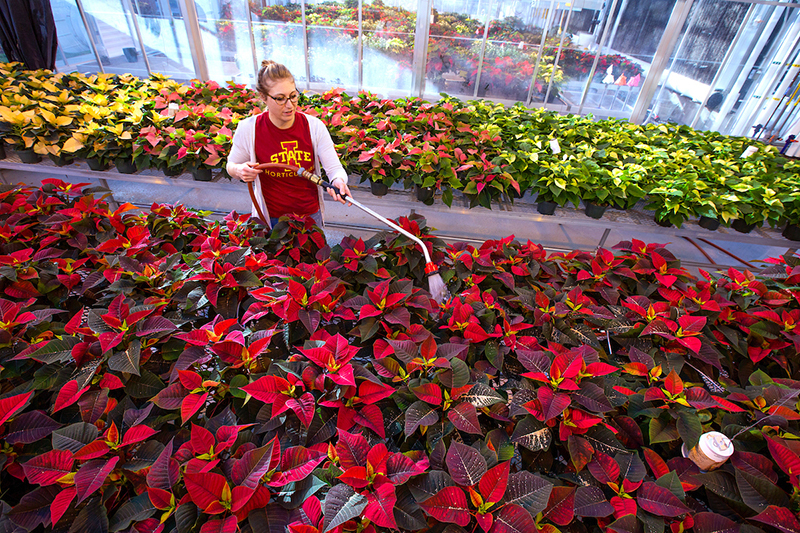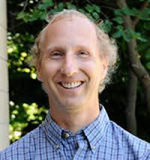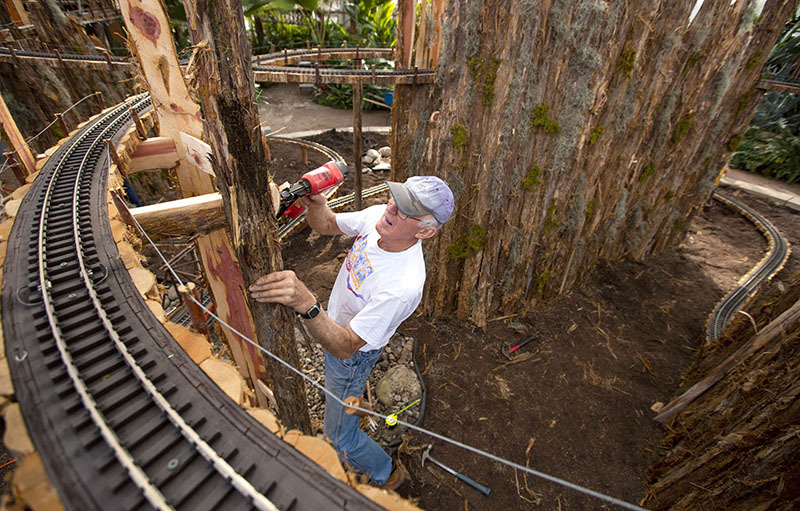Sea of color

Photo by Christopher Gannon.
Horticulture senior Amanda Van Scoy, who's also leading the horticulture club's poinsettia sale next month, waters some of the 400-plus plants Wednesday being prepped for the sale in the Horticulture Hall greenhouses. Club members grew five varieties of poinsettias this fall which will be sold Dec. 4-7 at various campus locations. Online pre-orders can be placed through noon Nov. 21.
New CELT faculty fellows aim to grow impact
Clark Coffman and Rob Whitehead may have different responsibilities as the newest faculty fellows at the Center for Excellence in Learning and Teaching (CELT), but they both are trying to make connections that will benefit individuals and the community.
Coffman, an associate professor in genetics, development and cell biology, is CELT's graduate student and postdoctoral professional development faculty fellow, and Whitehead, an associate professor in architecture, is the high-impact practices fellow. The half-time appointments began this summer and last three and two years, respectively.
Leading initiatives
Whitehead's role centers around three initiatives -- service learning, project-based learning and open educational resources.
Service-learning curriculum incorporates community service into course instruction -- for example, a city park clean up that leads to better waste disposal and recycling through data collection.

Whitehead
"Service learning happens across all of the colleges in many different ways, but currently there is no common way to designate what courses are service-learning courses," Whitehead said. "One of my responsibilities is to get a group of people together who are doing service learning around campus and try to have us teach and learn from each other."
Whitehead wants to determine best practices and offer advice to instructors who want to modify or develop a service-learning course. Service-learning teaching and learning communities are underway, meeting once a month. Megan Myers, an assistant professor in world languages and cultures and Iowa Campus Compact engaged scholar research fellow, is helping lead the group.
"This is meant to engage the faculty, and then the faculty deliver the courses in a way that is effective for students," Whitehead said.
Whitehead also is coordinating project-based learning, focused on different ways courses or activities can be taught.
"It is essentially the idea of brainstorming, testing and implementing," he said. "This happens all over in architecture, engineering, ag and business. It often happens in capstone classes all around campus, but before this fellowship, there was no common practice."
Whitehead believes project-based learning will create even more interdisciplinary interaction. The first workshops are being designed for the spring semester. Ideally, this would dovetail with work that will happen at the Student Innovation Center, opening in January.
In addition, Whitehead will serve as CELT's lead on open educational resources, which includes the Miller Open Education Mini-Grants.
Preparing future faculty
Coffman directs CELT's four-course preparing future faculty program designed for graduate and postdoctoral students pursing faculty careers. Participants are aided throughout the process by self-chosen faculty mentors who are not their thesis advisers.
"Since we are a universitywide program we can't really focus on individual disciplines," said Coffman, who took over the 18-year-old program from professor of veterinary pathology Holly Bender. "We provide the large-picture view, and the faculty mentor provides the discipline-specific information."

Coffman
The first semester-long course covers the expectations of what faculty encounter at different institutions, from community colleges to top research universities. Participants create and polish cover letters, research statements and vitae.
"We have faculty panels come in from a whole spectrum of institutions and talk about what faculty life is like, what the promotion and tenure process is like and how to put together an application," Coffman said. "We tell the students this course really is about finding your fit."
The next course continues work on job materials, such as diversity statements, but shifts focus to pedagogy. The third class provides teaching experience -- greater than a teaching assistant -- that could include teaching a section of a mentor's course. The final class is an independent study that can range from preparing research grants to portfolio development. The program could be completed in a semester and a half as some courses can be taken simultaneously.
Participants who complete the first two courses earn the designation of a preparing future faculty associate. Those who complete three courses are fellows, while finishing all four earns them the label of scholar. The levels of distinction can be beneficial when trying to land a first job.
"Being part of this program sets you apart, especially having this level of teaching experience in the classroom," Coffman said.
Seventy students enrolled in the first course this fall. Coffman is assisted by CELT program coordinator Karen Bovenmyer, who has helped guide 961 students through the program since its inception in 2002.
Coffman and Bovenmyer also work closely with the Center for the Integration of Research, Teaching and Learning on campus, a national program focused on effective teaching practices in higher education.
He also collaborates with the School of Education's graduate student teaching certificate program aimed at graduate students looking to become professors.
"It is like preparing future faculty plus," Coffman said.
Connect Four offers community, opportunity for students of color
When Brian Le came to Iowa State after a year as an undergraduate at Drake University, the transition was challenging. Being on a campus so large was difficult. So was being on a campus so homogenous. Le, a Des Moines native and son of Vietnamese refugees, came from a high school where students spoke more than 20 different languages. Ames was eye-opening.
"I didn't realize how predominantly white it was," Le said.
Connect Four, a College of Human Sciences program that provides community and mentoring for the college's first-year students of color, was a saving grace. It provided Le an avenue to meet diverse peers, guidance on how to thrive and a feeling that he wasn't alone.
"It helped me understand that I wasn't the only one struggling trying to navigate with my identities on campus," said Le, who later worked as a Connect Four peer mentor and is now a student programs coordinator with the Science Bound program. "It was a great jump-start to getting involved."
Connect Four has aimed to provide experiences like Le's since its founding in 2010 -- uniting, informing and engaging students, some who later return the favor.
"Lots of students are trying to figure themselves out, and this gives them a place to do that, to branch out and be able to come back and give back," said Human Sciences multicultural liaison officer Carmen Flagge, who runs the program.
Connect Four's name references its goals to connect new students to four pillars, Flagge said: academic resources, faculty, the university and each other. Every transfer and freshman in the college who identifies as a person of color is invited to join Connect Four, which a few years ago officially organized as a nonresidential learning community. It's one of several college-based learning communities for first-year multicultural students, including Design's Building up Leadership in Design (BUILD), Engineering's Leadership through Engineering Academic Diversity (LEAD), Agriculture and Life Sciences' Fostering Opportunity and Collaboration through Unity and Scholarship (FOCUS) and Liberal Arts and Sciences' Bridging Opportunities in Leadership and Diversity (BOLD).
In the know
The group meets twice a month for an hour at supper time, with a meal provided and a topic on tap. Thirty-five of the 123 eligible students were at the first meeting this fall, numbers that have been growing in recent years. They learn about resources and opportunities, whether it's study abroad experiences, scholarships or the one course per semester of free group tutoring multicultural student affairs funds for all students of color. Participants are more apt to succeed in the classroom, with a first semester GPA a half-grade higher than nonparticipants last fall, Flagge said.
"College, in general, can feel like some people are in the know and some people aren't. If you don't know, then you don't know, 'Oh, I could be a part of that? I could do that?' Someone needs to tell you," she said. "Those little things really matter."
Visiting speakers at the meetings present on issues such as financial aid, health and wellness, and believing in yourself. Flagge encourages faculty and staff speakers to talk about their own experiences with college to make them more approachable.
"It's about seeing them as a helping hand, someone who will work with you," she said.
Having faculty speak at Connect Four meetings also gives many of the speakers a new perspective, Flagge said.
"Having them come to us gives faculty an opportunity to really see our students.
They're able to see they have a desire to learn," she said.
The meetings, which some students continue attending after their first year, can be a time to vent. Sometimes that's necessary, Flagge said, noting the recent instances of racist vandalism on campus and the student activism in response.
"There are opportunities to process that and be in a space where they don't have to fight, where they can just be and be cared for," she said.
During Human Sciences Week, Connect Four students are invited to a faculty-staff dinner at the Joan Bice Underwood Tearoom. Throughout the year, students can sign up for one-on-one sessions weekly with peer mentors, and individual midterm meetings peer mentors, Flagge or graduate assistant Kasandra Diaz are encouraged.
Lasting impact
Le said the mentoring he received in Connect Four was powerful and relevant, helping draw him out. "If you're able to connect with one person, you're able to connect with others. It opens new doors every time," he said.
One of those doors was an alternative spring break service trip Le took to a women and children's homeless shelter in Atlanta. The week of volunteering changed his life and drove him to lead his own service learning spring break trip volunteering at a substance abuse rehabilitation farm in Colorado.
"It helped shape my identity on what it means to give back to others," he said.
A big aspect of the retention programming Le developed for Science Bound centers around the peer mentoring and leadership experiences he took away from Connect Four, as well as the community. He said the family vibe of the program made a difference and had lingering effects.
"Some of the students who were part of that program with me, we still catch up. It's a journey we all went through," he said.
Students appeal to regents to act
State Board of Regents president Mike Richards said the board won't organize campus forums -- one on each of the three regent campuses -- demanded by students during the public comment portion of the board's Nov. 13 meeting in Cedar Falls. But he said board members might attend any such forums.
"They [students] were respectful of the board, and I certainly respect them," Richards said. "The regents don't call public forums, but we would consider going to those."
Dozens of college students from both public and private schools in the state converged on the board meeting at the University of Northern Iowa to address primarily two topics: the impact of tuition hikes, particularly on underrepresented students, and a perceived lack of response to incidents of racism on the campuses.
Board members didn't respond at the time to the comments, though Richards noted they never do during the public comment portion of each meeting.
"The public talks to us, and we listen," he said.
During her campus update to the board, President Wendy Wintersteen said Iowa State is committed to assuring all ISU students -- including the record 24.5% this fall who identified as international or U.S. multicultural -- have "the tools, resources and support to reach their full potential."
She said university leaders responded Nov. 13 to demands late last month from the campus group Students Against Racism. Both the demands and the university responses are posted on Iowa State's campus climate website.
"We value our students standing up against racism, and we stand with them," Wintersteen said.
Economic impact, part 1
Hannah Ruffridge, assistant director of higher education consulting for Emsi, presented an overview of the firm's seven-month project for the board -- an analysis of the economic impact and return on investment of Iowa's three public universities using fiscal year 2018 data. Emsi is a labor market analytics firm based in Moscow, Idaho, and previously completed studies for 30 other statewide systems. She said Emsi is known for its conservative methodology, looking at added income to the state rather than sales, and comparing that data to a scenario in which (in this case) the regent universities didn't exist.
In FY18, Ruffridge said the regent system added $11.8 billion to the state economy. That figure represents 6.2% of Iowa's gross state product, she noted, and supports the equivalent of 149,980 jobs. One of 14 jobs in the state is supported by the activities of the universities and their students, she said.
Iowa State's portion of that economic impact is $3.4 billion. The full reports, executive summaries and fact sheets (systemwide and school-specific) are available on the regents website.
Richards said the board will use the data for planning and communicating with key audiences around the state.
"It clearly shows the impact our universities have on our state," he said.
Regent universities: Combined annual spending impacts
|
University operations |
$1.9 billion |
|
Construction |
$32.7 million |
|
U of Iowa Hospital and Clinics |
$1.5 billion |
|
Research |
$730 million |
|
Extension and outreach* |
13,000 companies and organizations |
|
Economic development |
$1 billion |
|
Out-of-state visitors to campus |
$38.1 million |
|
Volunteerism (2.3 million hours) |
$54.2 million |
|
Nonresident student spending** |
$232.9 million |
|
Alumni (earnings, business profits)*** |
$6.2 billion |
*"Difficult to quantify"
**Factors in a portion of Iowa residents who stayed (but would have left if regent universities didn't exist)
***One year based on 30 years of data
Economic impact, part 2
In his annual report to the board, interim vice president for economic development and industry relations David Spalding said economic development is "deeply in our genes" as the state's land-grant university.
The 2019 fiscal year, which concluded June 30, featured 165 faculty disclosures of intellectual property to the office of intellectual property and technology transfer, a 14% increase over the previous year. Those disclosures led to 98 patent applications, with 32 patents granted by the federal government. Spalding said the university signed 46 new license or option agreements with companies around the world for ISU-developed technology during FY19, bringing the total number operating and producing income during the year to 155. Finally, he said those agreements resulted in worldwide sales exceeding $88 million, $8.3 million of which was in Iowa.
ISU building projects
The board approved a schematic design and budget ($10 million) for renovations to floors 4-6 at the Memorial Union. The project will dismantle former residence/hotel rooms to create office suites for student-focused services. It also updates the heating/cooling, electrical, communications and security systems on all three floors and locates restrooms centrally near the elevators. Scheduled tenants include the veterans center, student legal services, study abroad, LGBTQIA+ student success, NCORE/ISCORE planning, lectures series and international students and scholars. MU revenue bonds will cover the entire cost. Construction is scheduled to begin in January 2021 and last about 20 months.
ISU leaders also received permission to begin planning to replace the College of Human Sciences' 61-year-old LeBaron Hall with a facility about 70% larger. The project also renovates a small section of the adjoining MacKay Hall. The university's evaluation of LeBaron Hall found it to be a poor candidate for renovation. The funding proposal for the estimated $55 million cost includes state appropriations ($30 million), private gifts ($15 million) and university funds ($10 million). A three-year funding request will go before the 2020 Legislature.
Admissions index
The board approved adding computer science to the course categories in the Regent Admissions Index, the formula the three universities use to automatically admit Iowa residents. Computer science joins the five original categories: language arts, math, social studies, science and foreign language. The regents' admissions study team asked three computer science faculty members to review all courses offered in Iowa high schools that meet K-12 standards set by the Computer Science Teachers Association and identify which had the depth to serve as college prep coursework. The trio identified four courses: IB computer science, computer science principles, AP computer science principles and AP computer science A.
In other business, the board approved these ISU requests:
- Effective Jan. 1, 2020, a change to the regents' catastrophic illness policy (section 2.1.4.A) to allow faculty and staff working at least half-time who don't accrue vacation -- such as nine-month faculty -- to receive vacation leave donations for a catastrophic illness or injury. Currently, employees who don't accrue vacation aren't eligible to receive such donations.
- Professional development assignments during the 2020-21 academic year for 48 faculty members. The list includes 32 semester-long assignments, 14 for the full academic year and two for the 2021 calendar year. The faculty group includes 26 professors, 16 associate professors and six assistant professors.
- Additional renovations in the Union Drive Community Center that provide new seats and tables, new ceiling, floor and wall finishes, and energy-efficient lighting in the Marketplace dining center. The work will be phased over three summers (2020-22) to minimize service disruptions. ISU Dining funds will cover the project.
- A schematic design and budget ($5.9 million) to replace the slate roof on all seven sections of Friley residence hall with asphalt shingles. The project, which also will repair dormers and replace gutters as needed, will be phased over two summers, 2020 and 2021.
- A gift of 262 acres (three parcels) in Lucas County, two miles east of ISU's McNay Research Farm. The university will use the land for research plots. Land owner Ronny Tharp's intention is that the land become part of the university's farms and not be sold for 50 years.
- A name for the under-construction feed mill and grain science complex at the Curtiss Farm west of Ames: Iowa State University Kent Corporation Feed Mill and Grain Science Complex. Muscatine-based Kent Corp. provided the lead gift of $8 million for the $21 million complex.
- Closure of two centers. The Industrial Assessment Center's most recent federal grant expired five years ago. The Center for Plant Responses to Environmental Stresses has insufficient funding to operate as a separate center, but the research continues in the plant pathology and microbiology department.
The board's next meeting is Jan. 15-16 in its Urbandale office.
Know what to do when severe winter weather hits
Campus already has seen winter weather with snow hitting the ground on a couple of occasions, but this is just the beginning of the season. Here's a reminder of Iowa State's guidelines when severe winter weather hits.
Last year was a rarity
Dangerously cold weather last January led to university administrators calling off classes and closing campus offices for two and a half days. That is rare. How rare? It was only the sixth time ISU offices closed since 1971.
How to find out about cancellations or closings
Start at the Iowa State homepage, and don't forget to refresh the page when weather is a concern. Closings and cancellations also will be posted on the ISU Facebook and Twitter accounts and broadcast on area TV and radio stations.
More information
The university usually stays open when classes are canceled
Even if classes are called off, ISU offices normally are open and employees should plan to work. If travel safety is a concern, contact your supervisor and request to make up missed time or take vacation or leave without pay. Always err on the side of safety, and supervisors should accommodate employees who can't make it to campus.
What happens if the university closes?
Vital operations -- for example, police, parking, food service, power plant, critical maintenance and snow removal -- generally remain open. Employees should follow policies established in their units and contact a supervisor if they are unsure if they need to work. Faculty and professional and scientific staff whose work responsibilities aren't based on a specific schedule should consult with unit leaders and adjust as needed. All other employees are expected to either make up missed time or take vacation or leave without pay.
Where to park
If your parking lot has not been cleared yet, don't park there. There are three designated lots during inclement weather where all ISU parking permits will be honored:
- Southwest corner of Iowa State Center (lots A3, A4, B5 and B6)
- North of Molecular Biology Building (lots 29 and 30)
- North of General Services Building (lot 41)
During poor weather, CyRide adds buses to its routes. Free shuttles run to campus from the Iowa State Center lots every five to 10 minutes.
A holiday favorite returns

Volunteers like Ames resident Carroll Marty, pictured, help Reiman Gardens staff assemble the RG Express holiday train exhibit in the conservatory. The display, in its fifth year, takes about 60 people more than 500 hours to set up. Photos by Christopher Gannon.
In its fifth year, Reiman Garden's RG Express train display returns to Hughes Conservatory for the holidays. The exhibit, open Nov. 24-Jan. 4, includes upper and lower tracks with G-scale trains winding through an Iowa State-themed landscape.
Miniature reproductions of campus landmarks are included in the exhibit constructed mostly of natural materials. This year's addition is the Christina Reiman butterfly wing, crafted from sticks, bark, driftwood, fungus and dried flora. Small-scale versions of the campanile, Hub (including a working version of the Dinkey train), Marston water tower and Beardshear and Morrill halls also are part of the exhibit. A 2-foot replica of Elwood, Reiman Gardens' giant concrete gnome, is tucked into the display.
Visitors will hear recorded carillon music playing from the campanile and cascading water from falls built into the display. Vegetation in the exhibit ranges from poinsettia varieties to the tropical plants on permanent display in the conservatory.
Admission to Reiman Gardens is $9 for ages 13-64, $8 for seniors, $4.50 for youth and free for members, ISU students and children age 2 and younger. The gardens are open 9 a.m. to 4:30 p.m. daily, with the exception of Thanksgiving Day, Christmas Day and New Year's Day.
